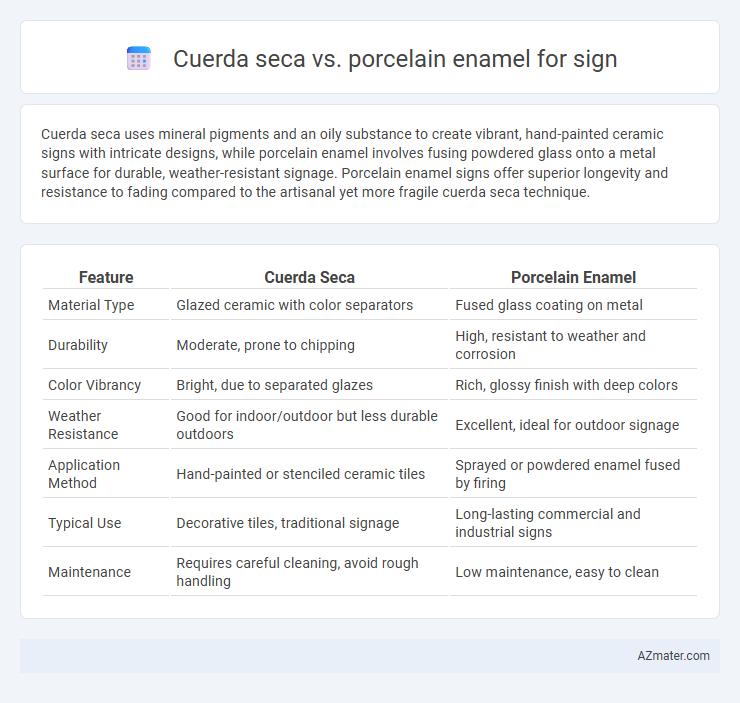Cuerda seca uses mineral pigments and an oily substance to create vibrant, hand-painted ceramic signs with intricate designs, while porcelain enamel involves fusing powdered glass onto a metal surface for durable, weather-resistant signage. Porcelain enamel signs offer superior longevity and resistance to fading compared to the artisanal yet more fragile cuerda seca technique.
Table of Comparison
| Feature | Cuerda Seca | Porcelain Enamel |
|---|---|---|
| Material Type | Glazed ceramic with color separators | Fused glass coating on metal |
| Durability | Moderate, prone to chipping | High, resistant to weather and corrosion |
| Color Vibrancy | Bright, due to separated glazes | Rich, glossy finish with deep colors |
| Weather Resistance | Good for indoor/outdoor but less durable outdoors | Excellent, ideal for outdoor signage |
| Application Method | Hand-painted or stenciled ceramic tiles | Sprayed or powdered enamel fused by firing |
| Typical Use | Decorative tiles, traditional signage | Long-lasting commercial and industrial signs |
| Maintenance | Requires careful cleaning, avoid rough handling | Low maintenance, easy to clean |
Introduction to Cuerda Seca and Porcelain Enamel Signs
Cuerda seca is a traditional decorative technique that uses a waxy resist to create intricate, multicolored ceramic tile designs, often seen in historic and artisanal signage. Porcelain enamel signs consist of powdered glass fused to metal at high temperatures, producing a durable, weather-resistant surface with vibrant colors and a glossy finish. Both methods offer unique aesthetic and functional benefits, with cuerda seca providing artisanal detail and porcelain enamel ensuring long-lasting durability.
Historical Background of Cuerda Seca and Porcelain Enamel
Cuerda seca, a technique originating in the Islamic world during the 10th century, became prominent in medieval Spanish and Moorish tilework, characterized by its use of greasy lines to separate colored glazes during firing. Porcelain enamel, developed in the early 19th century, evolved from traditional vitreous enamel processes and gained industrial significance for durable, vibrant signage by fusing powdered glass to metal at high temperatures. Both methods reflect distinct historical trajectories--cuerda seca rooted in artisanal ceramic craftsmanship and porcelain enamel emerging from industrial advancements in enamel technology.
Material Composition: Comparing Cuerda Seca and Porcelain Enamel
Cuerda Seca combines ceramic glazes separated by grease lines, creating intricate, colorful patterns on a clay base, while Porcelain Enamel consists of powdered glass fused onto a metal substrate through high-temperature firing, offering a durable, glossy finish. The organic grease lines in Cuerda Seca allow for segmented color areas, whereas Porcelain Enamel provides a seamless, smooth surface ideal for vibrant, long-lasting signage. Material-wise, Cuerda Seca offers artisanal texture and richness intrinsic to clay, contrasting with Porcelain Enamel's robust metal foundation designed for outdoor resilience and corrosion resistance.
Manufacturing Processes Explained
Cuerda seca involves hand-painting colored glazes separated by a resist line made of greasy substance to prevent mingling during firing, creating intricate and vibrant ceramic signs. Porcelain enamel manufacturing requires fusing powdered glass to metal substrates through high-temperature firing, resulting in durable, smooth, and glossy signage surfaces. The cuerda seca process emphasizes artistic detail with individual glaze applications, while porcelain enamel prioritizes robust industrial production with consistent finish quality.
Design Flexibility and Artistic Expression
Cuerda seca technique offers greater design flexibility by allowing intricate, multicolored patterns with precise outlines, enabling highly detailed and vibrant artistic expression. Porcelain enamel provides a smooth, durable surface with fewer color options and simpler designs but excels in longevity and resistance to fading. For signs requiring complex, colorful artwork with artistic nuances, cuerda seca is preferable, whereas porcelain enamel suits minimalist designs emphasizing durability.
Durability and Weather Resistance
Cuerda seca tiles offer excellent durability with a traditional wax-resist technique that prevents color blending, maintaining vibrant designs under prolonged sun exposure and moderate weather conditions. Porcelain enamel signs provide superior weather resistance due to their glass-like surface, which is highly resistant to fading, chipping, and corrosion from harsh elements like rain, UV rays, and temperature fluctuations. For long-term outdoor signage, porcelain enamel typically outperforms cuerda seca in durability, especially in extreme weather environments.
Color Vibrancy and Longevity
Cuerda seca technique produces signs with rich, vibrant colors due to its use of wax lines that prevent color bleeding, enhancing precision and saturation. Porcelain enamel offers exceptional longevity through its durable, glass-like surface resistant to fading, chipping, and weathering, ensuring signs maintain clarity over decades. While cuerda seca emphasizes intense color vibrancy, porcelain enamel excels in long-term durability and color retention under harsh environmental conditions.
Maintenance Requirements and Cleaning Tips
Cuerda seca signs require regular maintenance to prevent color fading and protect the intricate copper lines from corrosion, often needing gentle cleaning with mild soap and water to avoid damaging the glaze. Porcelain enamel signs are highly durable, resist scratches and chemical stains, and can be cleaned with a non-abrasive cloth and mild detergent to maintain their glossy finish over time. Both materials benefit from avoiding harsh chemicals and abrasive tools to preserve their appearance and extend longevity.
Cost Considerations for Each Technique
Cuerda seca techniques often involve detailed handwork, increasing labor costs compared to porcelain enamel, which benefits from automated production processes that lower overall expenses. Porcelain enamel signs typically require expensive kilns and specialized materials but offer high durability and long-term cost savings through reduced maintenance. Cuerda seca's intricate patterns and slower production time may lead to higher upfront costs, whereas porcelain enamel offers a more cost-efficient solution for mass-produced signage.
Choosing the Best Sign Technique for Your Needs
Cuerda seca offers vibrant, detailed designs ideal for artistic, high-resolution signage requiring rich color separation, while porcelain enamel provides unmatched durability and resistance to harsh weather, making it perfect for long-lasting outdoor signs. Selecting the best sign technique depends on prioritizing either intricate visual appeal with cuerda seca or robust performance with porcelain enamel in demanding environments. Evaluate factors like location exposure, desired lifespan, color complexity, and budget to determine the optimal method.

Infographic: Cuerda seca vs Porcelain enamel for Sign
 azmater.com
azmater.com